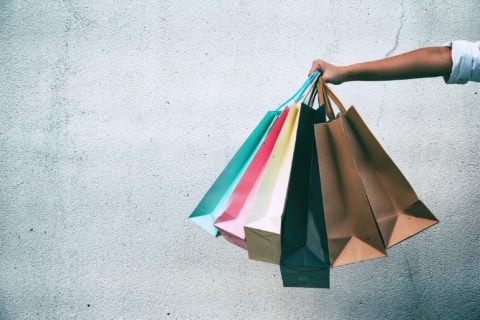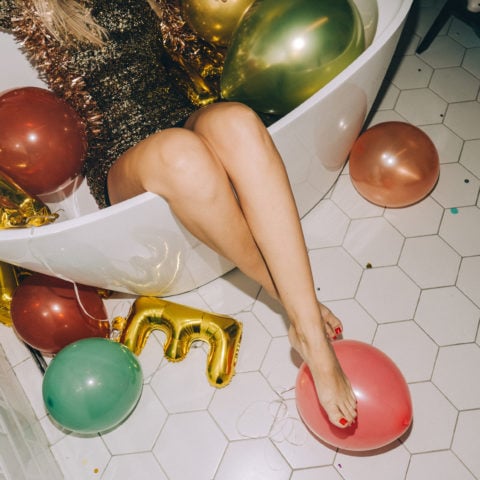How A Year of Shopping Abstinence Gave One Compulsive Consumer Clarity
"What I really wanted was rarely the item itself but the acquisition of it: a shiny new object to fill a void."
Before online shopping, I never thought I had an addictive personality. I feel indifferent to recreational drugs, drink wine primarily to learn about grapes and am far too risk-averse to gamble. Yet show me a seasonal sale and I’ll show you a person who is in too deep to see it: a frenzy of tabs opened, eyes blurry from scrolling, a pallid face illuminated by a computer screen. Saying no to vices, all things considered, was easy. Saying no to a better dressed, more impressive, idealistic vision of myself? Impossible.
Five years ago, I went into debt because of this obsessive behaviour, having filled my life with raw-silk dresses from L.A. and architectural coats from Denmark in an effort to disguise a lukewarm self-image. I lied to those around me about it, concealing shopping bags from my partner and waiting until he was out of the house to remove the tags. I knew I had a problem, and over the years, I chipped away at it, denying myself a purse here, returning a necklace there. Slowly, my bank account recovered and my fixations subsided.
But the impulse stayed—simmering beneath the skin, always threatening to come to a full boil. I wanted to study it and get to know the anxieties that fuelled it, but to gain such a perspective required distance. So when I made the resolution to stop shopping for a year, it wasn’t as a monastic last resort but a deliberate decision to take a step back and condition myself into being a more mindful consumer. It wasn’t about taking away my choices but about making one.
Not everything triggered my compulsive instinct for acquisition, so I kept the ban limited to the things that did: clothing, jewellery and shoes.
Not everything triggered my compulsive instinct for acquisition, so I kept the ban limited to the things that did: clothing, jewellery and shoes. The benefits, I reasoned with myself, were manifold. By not mindlessly browsing the internet for things to fill my closet, I would save a lot of time. By not purchasing them, I would save money. And by not creating more demand for the fashion industry, I would save the planet. (Admittedly a stretch. But I would be, at the very least, less complicit in the environmental impact of clothing production.) The most salient argument of them all: By learning to take the impulsive emotion out of shopping, I would eventually save my mental health.
I started the ban on a Thanksgiving weekend. “Brave,” said a friend with whom I’d shared the news so as to be held accountable. “You’re going to get so many emails.” She was right. They came like a deluge, each offering a sale more enticing than the last. Deleting them unread would have been easier, but I didn’t want to spend a year playing ostrich, so I decided to confront my inbox. Like a one-woman study on the efficacy of exposure therapy, I opened the emails one by one. To my surprise—and to my credit—the force of sheer willpower triumphed. I survived Black Friday. Then came Cyber Monday. Then Boxing Day. On my 30th birthday, I bought nothing to “treat myself”—a historical first.
On occasion, I would feel the familiar restlessness re-emerge, the squirrelly desire to get my hands on something new. It would be triggered by an Instagram photo, say, of a woman draped in luxurious fabrics captured as she walks past the camera. There would be movement in the photo and amazing light. Maybe she’s in Montmartre… or SoHo. Wherever she is, it’s the perfect portrait of elegance and grace, and if I were to acquire the cashmere sweater in the photo, I, too, could have it all. Or… I could keep scrolling.
What I really wanted was rarely the item itself but the acquisition of it: a shiny new object to fill a void.
Refraining from acting on these feelings, however challenging at the time, eventually gave me the mental clarity to observe them. What I really wanted was rarely the item itself but the acquisition of it: a shiny new object to fill a void. The void came in many forms: insecurity, anxiety, depression, impending burnout. Like an itchy throat heralds the arrival of a cold, my compulsion to shop always revealed itself to be symptomatic of a deeper discontent.
Thankfully, dopamine comes in other forms, too: taking a long, unhurried walk; learning to make a complicated dessert; calling someone just to hear their voice. It’s the joy of novelty without acquisition—therapy without the retail. When I’m reading books, I’m not buying books. By that, I mean the more I spend my time living deliberately, the less I get caught up in the need to embellish my life with stuff.
They say creativity thrives under constraints, which proved true throughout the ban. I was forced to confront the things I owned and find new contexts for them. I learned to create the spark of novelty by putting two old items together for the first time. I learned to see their usedness not as a strike against them but as a testament to their quality. Most importantly, I learned that the ability to abstain from shopping for a year isn’t a lesson in deprivation but one in abundance—the privilege of having what you need and wanting what you already have.
This is not to say that I will never shop again but that I now question my instincts when I do: Am I using this purchase to distract myself from something else happening in my life? Am I trying to signal value or success or dress myself up as someone I am not? Like the choice between different lenses at the optometrist’s, these questions help provide clarity as to what motivations are truly at work. And some questions are reserved for the item, too: Is it comfortable? Is it durable? Is it something I will honour by wearing it frequently and with enthusiasm?
A year later, I have emerged on the other side of the ban less impulsive and more informed.
A year later, I have emerged on the other side of the ban less impulsive and more informed. And the way I engage with fashion has also changed. The fast-fashion retailers that used to flood my algorithm have largely been replaced by local consignment shops, vintage stores and ethical fashion resale communities.
Having abstained for this long, I don’t feel right about reverting back to buying cheap, disposable clothes—or about simply replacing them with more ethical counterparts. After all, the most sustainable approach to the way we dress is not to shop sustainable brands but to refrain from supporting the resource-intensive world of textile manufacturing when we can. So, for now, I am prioritizing taking care of what has already been made: extending the longevity of the garments I own and giving other people’s clothes a second life. Maybe I’ll start another year-long ban. This time, no new clothes.
As Vivienne Westwood famously advised, “Buy less, choose well, make it last.” What doesn’t last is desire—the glimmer of getting what you want that dulls when the transaction is over. But knowing that you can live without something—a new outfit, a temporary boost of confidence, a more photogenic life—is what stays with you. That’s what sets you free.








